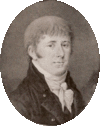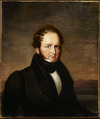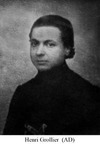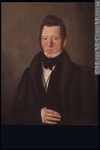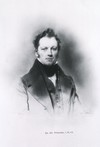sent to establish Fort Chipewyan (Alta) at the southwestern end of Lake Athabasca and was left in charge of the fort, which became the company’s headquarters in the region, during Alexander’s absences in
all his influence, and some force” to prevent Clarke from encountering Indians or trading with them. Nor’Wester Willard Ferdinand Wentzel, writing from Fort Chipewyan, expressed “exultation” at the
in the Athabasca department. The journals he kept at Fort Chipewyan (Alta) in 1799–1800 illuminate the harshness of life in the fur trade; they also reveal his contempt for Canadians, Indians, and the
was transferred in 1822 to the Athabasca district and accompanied Simpson that autumn from York Factory (Man.) to Fort Chipewyan (Alta). The governor appraised him as a “decent young man but not such a
liberated Clarke. Arrested by the persistent Samuel Black in October on charges of attempted murder and imprisoned in Fort Chipewyan (Alta), Robertson contrived to smuggle out messages to his men which
Mackenzie who had known him as a boy. Stuart was sent to Fort Chipewyan (Alta), and subsequently served at various posts in the Athabasca department. In 1805 he was assistant to Simon
beyond Île-à-la-Crosse as the NWC diverted Indian provisioners from Clarke’s path. In October he established Fort Wedderburn on an island in Lake Athabasca, across from the NWC’s Fort Chipewyan (Alta). He
) and James MacKenzie* of the “old” North West Company at Fort Chipewyan. When the two North West companies amalgamated in 1804, John
*. His descriptions of the Beaver (Slave) and Long-Arrowed (Hare) Indians are literate and detailed.
From 1816 to 1821 Keith served at Fort Chipewyan
charge of the Severn district and posted to Fort Severn (Ont.). The following year he was transferred to Fort Chipewyan (Alta), in the Athabasca country. His annual reports from both places showed a lively
.
Leroux remained at Great Slave Lake, despite the NWC’s decision to close this post because the partners considered it unprofitable. He reached Fort Chipewyan (Alta) in March 1789, and set off again at
-Crosse began to fall off in the early 1840s as the Chipewyan Indians who traded in this district moved into the plains region. McKenzie placed part of the blame for the desertion of his post by the Indians
young Chipewyan guides and reached the east end of Lake Athabasca. The six-week return trip was accomplished under difficult and sometimes hazardous conditions. The route surveyed, however, proved to be a
, Robertson commented on the influence Todd had exerted over the Chipewyans in his capacity as surgeon; his successful treatment of an outbreak of whooping cough gained a certain advantage for the HBC over the
for Oxford House and then Cumberland House where he took charge of the district, 1852–53. From 1853 to 1857 Bell supervised the company’s Athabasca District from Fort Chipewyan. Following a year’s
North West Company and was posted to the Athabasca Department and then to the Mackenzie River District, being stationed at Fort Chipewyan and at posts on the Mackenzie River and north of Great Slave Lake
June. He left there on 8 July to go to the Lake Athabasca mission at Fort Chipewyan, where he lived from 1852 to 1856 and from 1857 to 1858. In 1853 he founded a mission at the Fond-du-Lac trading
Fort Chipewyan; he was arrested at Fort Wedderburn in May 1820 for complicity in the outrages perpetrated at Île-à-la-Crosse by Peter Skene
Chipewyan. His first winter command was at Fort Resolution, on Great Slave Lake, from 1819 to 1823. With the amalgamation of the fur-trading companies in 1821, McVicar became a chief trader. He gave
; the group travelled overland from New York to Albany, Niagara, Fort William (Thunder Bay, Ont.), Fort Chipewyan, Great Slave Lake, the Mackenzie River, and Fort Franklin on Great Bear Lake, where they






